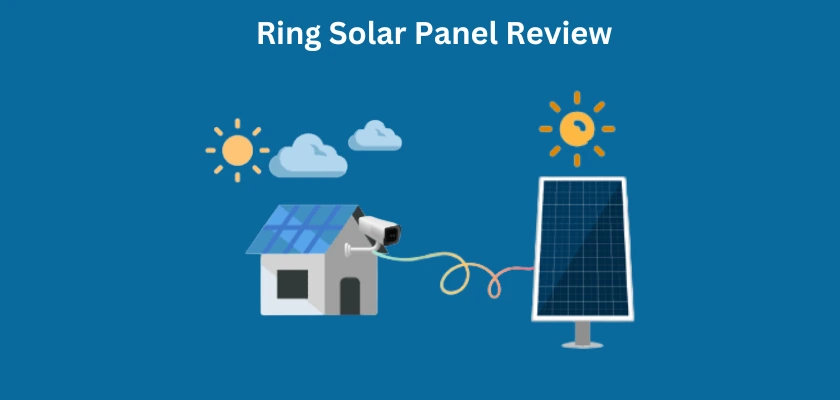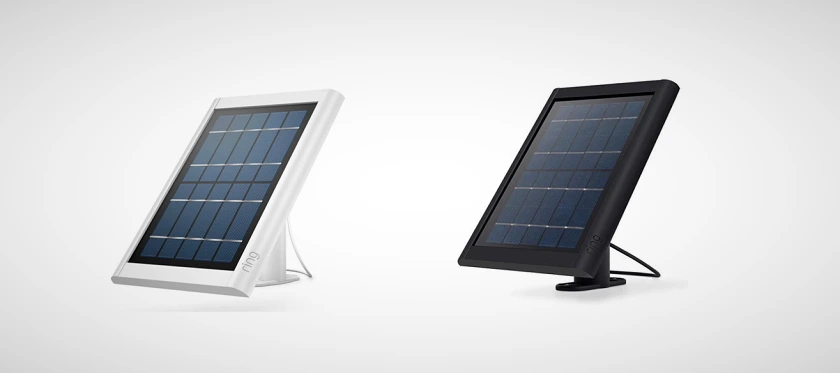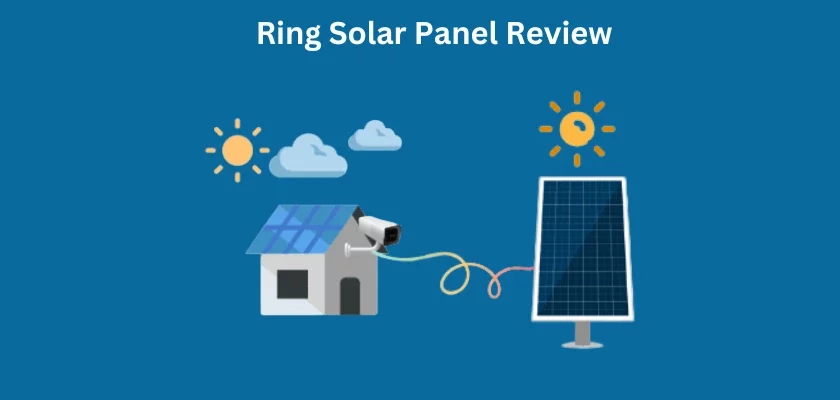
This Ring Solar Panel review has been designed to teach, enlighten, and make available, valuable information as to what this device is all about, and overall expectations with using it.
The Ring Solar Panel just like any other solar panel is designed to provide an alternative source of electrical power to your electrical devices. Ring as a brand is well-known in the home security market. The brand features several smart home devices that cater to the needs of home security, and Ring also sits comfortably with a lot of users around the world.
The Ring Solar Panel comes in four models and these solar panels are devices the brand has designed to keep specific Ring cameras running continuously, and enhance the overall useful life of their batteries. Also, these Ring Solar Panels are eco-friendly and convenient sources of electrical power to traditional sources of electrical power. Although traditional sources of electrical power carry very large voltages and are converted to small voltages for small electrical devices using an A.C to D.C adapter, the Ring Solar Panels produce small voltages that are required for small devices and in this case security cameras. We shall discuss all these and more as we move along in this review.
Let’s get started.

Overview of the Ring Solar Panels
Essentially, the Ring Solar Panels are designed to provide a balance between your camera’s battery usage and recharge. This is necessary because a battery-powered camera is designed to have battery discharges and recharges to keep the battery at optimum performance. Now, this doesn’t mean that the battery has to drain completely, it just means there has to be some room for the battery’s power to be utilized and then replenished.
As mentioned in the introduction, the Ring Solar Panels are in four models which are; the Ring Small Solar Panel (1.9 Watts), Ring Solar Panel (2.4 Watts) [designed for the Ring Spotlight Camera Battery and Ring Stick Up Camera Battery – 2nd & 3rd Generation], the Ring Solar Panel (4 Watts), and the Ring Super Solar Panel (5 Watts) [designed for the Ring Spotlight Camera Battery & the Ring Stick Up Camera Battery – 2nd & 3rd Generation].
You may be wondering why there are different Ring Solar Panels designed for the Ring Spotlight Cameras and the Ring Stick Up Cameras, 2nd and 3rd generation; we will explain this.
The obvious reason is that some of the Ring Solar Panels are improved models of the former and have the capacity to produce more electrical power and charge your camera faster. We will explain this further when we get to the overview of each of these Ring Solar Panels. Let’s begin with the Ring Small Solar Panel (1.9 Watts).
Overview of the Ring Small Solar Panel (1.9 Watts)
This Ring Solar Panel is a small and compact device measuring 6.9 x 4.4 x 0.5 in
(17.5 x 11.1 x 1.2 cm). A solar panel works by simply sucking up the rays from the sun with its photovoltaic cells and converting this to electrical power. With the dimensions of the Ring Small Solar Panel, it is very well able to produce 1.9 Watts of power.
The most basic way to calculate electrical power is with the formula P=IV. Where P stands for Power in Watts, I stands for Current in Amperes or Milliamperes, and V stands for Voltage. It is important to understand this because you will find these values or ratings on any of the Ring Solar Panels or any other solar panel out there. Even on your Ring devices or any electrical device you own. Also, this will enable you to know what Power rating is supported and what’s not.
It is also worth mentioning that electrical power is in the form of D.C and A.C where D.C means Direct Current and A.C means Alternating Current. The latter is what you find in your home (your electrical sockets) and depending on your country, this may be 110 Volts or 220 Volts. Then with D.C, there is actually a conversion from A.C to D.C so that you have small voltages like 1.5 Volts, 3 Volts, 4.5 Volts, 5 Volts, 6 Volts, 9 Volts, 12 Volts, 24 Volts, etc. These small voltages can then be used with small electrical devices like your Ring security cameras.
Also, you may own cameras that are to be plugged directly into a Power socket with a D.C adapter. This adapter converts A.C. to D.C and is able to power the camera. But with a solar panel, D.C. electrical power is generated by conversion from the sun’s rays.
With this understanding of electrical power, the Ring Small Solar Panel is rated at 1.9 Watts, 5 Volts, and comes with a 6.5 ft (2 m) USB-C cable. It is designed with an outdoor operating temperature between -5°F to 120°F (-20.5°C to 48.5°C). With this, the device will be able to function optimally and produce the desired electrical power. It comes with an adjustable mounting base and supports other types of Ring mounts that are sold separately. These optional supported mounts are the Pole mount, the Gutter mount, and the Wall mount.
This Ring Small Solar Panel supports cameras with a USB-C input as well as Ring barrel plug input cameras. The latter is possible with a USB-C to barrel plug adapter.
| Cameras Compatible with the Ring Small Solar Panel |
| Ring Spotlight Cam Plus |
| Ring Spotlight Cam Pro |
| Ring Stick Up Cam Battery (2nd and 3rd Generation) |
| Ring Stick Up Cam Solar (2nd and 3rd Generation) |
| Ring Spotlight Cam Battery |
| Ring Spotlight Cam Solar |
Overview of the 2.4 Watts Solar Panel
This model is a higher-capacity panel measuring 7.75 in. x 5.50 in. x 0.50 in. (19.68 cm. x 13.97 cm. x 1.27 cm). Its rated electrical power is 2.4 Watts, it produces 5 Volts output, and comes with a 13 feet. (3.96 meters) cable with a weatherproof barrel connector.
It is designed with an outdoor operating temperature between -5°F to 120°F (-20.5°C to 48.5°C). It comes with an adjustable mounting bracket and supports Ring barrel plug input cameras as well as Ring USB-C input cameras using the Ring Barrel Plug to USB-C Adapter (Purchased Separately).
| Cameras Compatible with the Ring 2.4 Watts Solar Panel |
| Ring Stick Up Cam Battery (2nd and 3rd Generation) |
| Ring Stick Up Cam Solar (2nd and 3rd Generation) |
| Ring Spotlight Cam Battery |
| Ring Spotlight Cam Solar |
| Ring Spotlight Cam Plus |
| Ring Spotlight Cam Pro |
| Ring Alarm Outdoor Siren |
Overview of the 4 Watts Panel
This Ring Solar Panel measures 8.1 x 6.7 x 0.5 in (20.5 x 16.9 x 1.2 cm) to produce 4 Watts of Power and 5 Volts output. It comes with a 2 meters cable and USB-C connector. It is weather resistant with an outdoor operating temperature similar to that of its predecessors (-20.5°C to 48.5°C).
This model also comes with an adjustable mounting base and supports the other types of Ring mounts that are sold separately. These are the Pole mount, the Gutter mount, and the Wall mount.
| Cameras Compatible with the Ring 4 Watts Solar Panel |
| Ring Spotlight Cam Plus |
| Ring Spotlight Cam Pro |
| Ring Stick Up Cam Battery (2nd and 3rd Generation) |
| Ring Stick Up Cam Solar (2nd and 3rd Generation) |
| Ring Spotlight Cam Battery |
| Ring Spotlight Cam Solar |
| Ring Alarm Outdoor Siren |
Overview of the Ring Solar Panel (5 Watts)
The 5 Watts Ring Solar Panel is the Ultra-powerful Ring Solar Panel designed to produce the most power possible. It measures 11.8 x 7.8 x 0.5 in (30 x 19.8 x 1.3 cm) and produces 5 Volts output.
Obviously, with its many photovoltaic cells, it will pick up quickly no matter how low the intensity of the sun is. It can deliver very quick and efficient charges to your Ring-supported devices. Also, if your camera is located in an area with so much traffic around the camera’s view, you can be rest assured that this RIng Solar Panel will deliver optimally. Essentially, the higher the capacity of a solar panel, the more it can deliver enough electrical power.
The following Ring devices are supported by this panel.
| Cameras Compatible with the Ring 5 Watts Solar Panel |
| Ring Stick Up Cam Battery (2nd and 3rd Generation) |
| Ring Stick Up Cam Solar (2nd and 3rd Generation) |
| Ring Spotlight Cam Battery |
| Ring Spotlight Cam Solar |
Installing the Ring Solar Panels
Mounting the solar panels is pretty straightforward and doesn’t require any special skills. However, you must ensure to find a suitable location. This is very necessary as it can determine the overall performance and output you get from the panels.
In finding a suitable location, it has to be a place that receives enough sunlight. It is also better if this location is where the sun would normally set out from. With this, your Ring Solar Panel can begin to generate power early enough for as many hours as the sun is available to you. Also, this location has to be free of shadows from trees, or barriers from neighboring houses, etc. Then again, you should be able to clean the panel when you have finally mounted it. This is so because dust does settle on panels generally during the dry season and as a result, they cannot adequately suck up the sun’s rays thereby reducing the total electrical power they can generate.
When you’ve found the appropriate position, simply go ahead and mount your Ring Solar Panel with the accessories included in the package. Then, plug the output cable into your Ring camera.
Performance of the Ring Solar Panels
Whichever panel you decide to go for, you can be rest assured that you will benefit optimally from the device. However, it will be better to go for the higher capacity panels provided that they are compatible with your Ring camera. Also remember that a solar panel can only deliver when it is receiving the sun’s rays. When the sun becomes unavailable, your camera’s battery continues the process of powering your camera till the sun is available again, and you do want your camera’s battery to be recharged to its fullest before the sun becomes unavailable. This is the reason why a higher capacity panel will be more beneficial.
You must also remember that on cloudy days you can’t rely on the solar panel. You may observe your camera charging but the panel may not get the job done depending on how discharged your camera’s battery is. Don’t also forget that your camera is in operation and the panel has to make up for this and also recharge the battery.
Final Thoughts
This Ring Solar Panels review clearly shows how these devices can provide the required balance between battery discharge and recharge, thereby enhancing the overall useful life of your camera’s rechargeable battery.
They provide the convenience you need in managing a battery-powered camera, along with their cost-effectiveness, eco-friendliness, and continuous power delivery to your Ring security cameras and other supported devices.
You may want to see our review of the eufyCam Solar Panel, the Lorex Solar Panel, or the Reolink Solar Panel.
